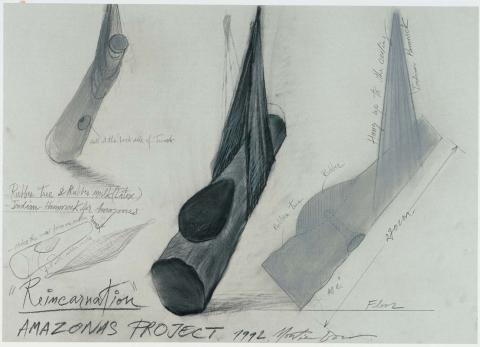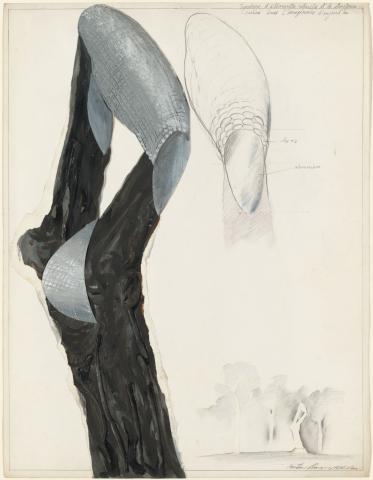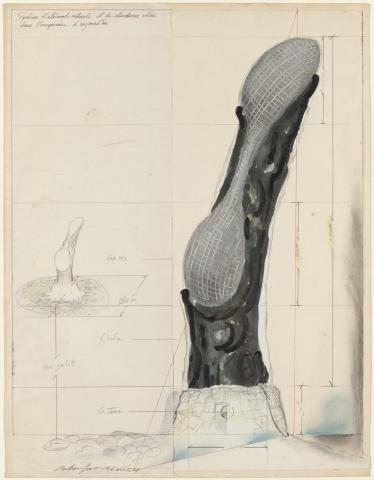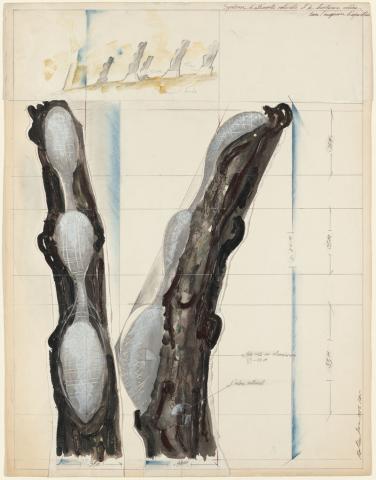ESSAY: Montien Boonma’s works on paper
Montien Boonma's (Study for sculpture) and two untitled works on paper all date from 1986, and are from his 'Symbiose d'elements naturels et de structures creux dans l'imaginaire d'aujourd'hui' (Symbiosis of natural elements and hollow structures in today's imaginary realm) series, 1986–87. All three are preliminary drawings relating to hybridised sculptural forms created by Boonma from wood and metal rivets. In common with two early works, Natural form in the present environment 1984 and A changing world no. 2 1984, this series of sculptures combines metal rivets with either tree branches or soil. Inserted into the wood, the rivets resemble an alien and parasitic element protruding from the tree trunks and retarding further growth. The works comment on Thailand's rapid transition from a traditionally rural and agrarian economy to an industrialised nation and also point to some of the environmental costs that such rapid development inevitably entails. Apinan Poshyananda comments, 'By nailing and screwing metal tips into the bark of a tree, [Boonma] forces the viewer to confront a kind of "pain" that can be seen everywhere in urban life'.(1) The tree form was to remain important to Boonma and appeared in early experimental works in Paris in 1987, including La maison d'espirit, L'Espace d'espirit and La Boite mystique and later in the 1992 work Reincarnation – Amazonas project.
The mid to late 1980s was a fertile period for Boonma's artistic practice and 1986 is often regarded as a turning point in his career. In 1985, he was awarded a Thai government scholarship to study a master's degree in sculpture in Europe. In 1986, he studied in Rome, and then in Paris at the Ecole Nationale Supérieure des Beaux-Arts. Boonma's residence in Paris is evident in the three works on paper, all of which have their components labelled in French: ('l'arbre' or tree and 'les vis en aluminium' or aluminium rivets/screws). The Thai art world was largely unsympathetic towards installation work at this point in time, and Boonma's studies in Europe enabled him to experience and have access to information on art movements such as Fluxus, Minimalism, conceptual art, performance art and environmental art. Artists such as Joseph Beuys, Donald Judd and Richard Serra would become strong influences. In the mid to late 1980s, Arte Povera's combination of assemblage and natural forms was also a significant influence on Boonma's work, evident in these works on paper.
These three drawings from the 'Symbiose' series were inspired by Boonma's observation of the clash between rural and industrial life in his native Thailand. They also relate to Buddhist ecological principles and to what is known as Green Buddhism, which combines an ethical approach to the environment and ecology with a belief in the sacred. Buddhist teachings encourage acting with respect and compassion towards trees, and incline to the belief that plants, forests, rocks and other elements of the natural world have sentience. Thus while not against modernisation, Boonma emphasises 'mindful living' and an 'awareness of the fragility and interdependence of human beings and nature'.(2) It is this awareness that his 'Symbiose d'elements naturels et de structures creux dans l'imaginaire d'aujourd'hui' series promotes and hopes to inspire in the viewer. As Boonma remarked:
'As an artist you are not an expert on environmental problems, but you realise that they exist. Then, if we are sincere about the situation, we can directly show it. But it is not the work of the artist that is the solution. It is the results of the work and what kind of thoughts it inspires in people.'(3)
Abigail Fitzgibbons, Research Assistant, Oct. 2005.
The mid to late 1980s was a fertile period for Boonma's artistic practice and 1986 is often regarded as a turning point in his career. In 1985, he was awarded a Thai government scholarship to study a master's degree in sculpture in Europe. In 1986, he studied in Rome, and then in Paris at the Ecole Nationale Supérieure des Beaux-Arts. Boonma's residence in Paris is evident in the three works on paper, all of which have their components labelled in French: ('l'arbre' or tree and 'les vis en aluminium' or aluminium rivets/screws). The Thai art world was largely unsympathetic towards installation work at this point in time, and Boonma's studies in Europe enabled him to experience and have access to information on art movements such as Fluxus, Minimalism, conceptual art, performance art and environmental art. Artists such as Joseph Beuys, Donald Judd and Richard Serra would become strong influences. In the mid to late 1980s, Arte Povera's combination of assemblage and natural forms was also a significant influence on Boonma's work, evident in these works on paper.
These three drawings from the 'Symbiose' series were inspired by Boonma's observation of the clash between rural and industrial life in his native Thailand. They also relate to Buddhist ecological principles and to what is known as Green Buddhism, which combines an ethical approach to the environment and ecology with a belief in the sacred. Buddhist teachings encourage acting with respect and compassion towards trees, and incline to the belief that plants, forests, rocks and other elements of the natural world have sentience. Thus while not against modernisation, Boonma emphasises 'mindful living' and an 'awareness of the fragility and interdependence of human beings and nature'.(2) It is this awareness that his 'Symbiose d'elements naturels et de structures creux dans l'imaginaire d'aujourd'hui' series promotes and hopes to inspire in the viewer. As Boonma remarked:
'As an artist you are not an expert on environmental problems, but you realise that they exist. Then, if we are sincere about the situation, we can directly show it. But it is not the work of the artist that is the solution. It is the results of the work and what kind of thoughts it inspires in people.'(3)
Abigail Fitzgibbons, Research Assistant, Oct. 2005.
- Apinan Poshyandanda, Montien Boonma: Temple of the Mind, Asia Society Museum, New York, 2003, p.15.
- Ibid.
- Arte Amazonas, Goethe Institut, Bangkok, 1992, unpaginated.



